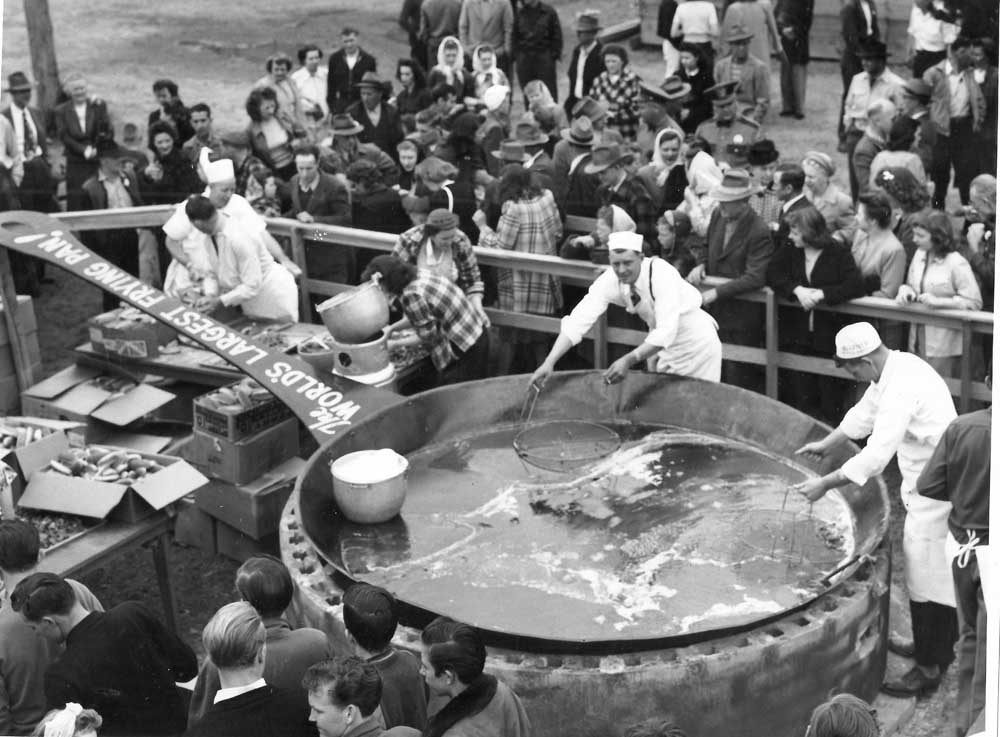Saints or Sinners? Characters of Pacific County: ‘W’ and the creation of legendary Long Beach
Published 1:42 pm Thursday, August 1, 2024

- Much of Long Beach’s success as a mid-20th century tourist attraction can be attributed to Wellington Marsh and other local promoters, who invented events like the annual clam fry in “The World’s Largest Frying Pan.”
Wellington Marsh (1895-2004)
Wellington W. Marsh (whose friends called him “W”) came to the Long Beach Peninsula from his native North Dakota — at first to visit his grandmother Elizabeth MacArthur (1849-1940)who had arrived, also from from North Dakota, in the early 1900s and owned beach cabins where Marsh’s Free Museum stands today. In 1926 he and his wife Harriet (Hattie) moved here permanently and began to seriously collect curiosities.
They lost no time in opening the original Marsh’s Café, and their first store, “Marsh’s Seashell Factory and Antique Shop.” On the Peninsula, Marsh marketed oysters on the side and the couple traveled the country buying shells and antiques in a bus fondly called, “The Old Blue Bonnet.’
Marsh promoted his businesses with an enthusiasm reminiscent of old-time medicine showmen, even hosting clam fries outside his museum in the World’s Largest Frying Pan and making incredible claims about the oddments in his collection. Although the business has expanded many-fold and has moved across the street from its first location, a “stop” at Marsh’s Free Museum is still considered “a must” by most visitors to the Peninsula, no matter how many times they have been there.
Trending
A veteran of the U.S. Navy in World War I, he was a member of the American Legion, active in Long Beach area business groups, and a family man who instilled in his descendants a well-deserved pride in the unique business he established…
From snake skins to weapons to bee hives to Soviet military medals, Marsh’s Free Museum has a plethora of curiosities to offer. The compelling taxidermy collection includes a two-headed calf, a cycloptic lamb, and a two-headed pig. Also, not to be missed among this amazing curio collection are a shark, a self-playing violin, America’s largest collection of glass fishing floats, and a (supposedly) real shrunken head.
The star attraction at Marsh’s, however, is Jake the Alligator Man. Purported to be half human, half alligator, and in a mummified condition, Jake is on display year ‘round. The curiosity was purchased for $700 by Wellington’s son Junior and his wife Marian in the mid-1960s from the Cliff House Museum in San Francisco.
Since then, Jake’s faithful followers have reached cult-like proportions, dressing up for several years in outlandish regalia for his “Annual 75th Birthday Celebration” and periodic weddings. It is rumored that nowadays, in his fragile condition, he depends upon a double (“Fake Jake”) to make obligatory celebrity appearances. He is also known to appear unexpectedly at local birthday or cocktail parties, often dressed in an elegant red smoking jacket and escorted by one of his many lady friends.
A cult figure in the Pacific Northwest, Jake has earned his own bumper sticker, has sold over 30,000 postcards, and was even featured in the ever-amusing Weekly World News. His dramatic story included an escape from captivity, a murder, and a murkily-detailed birthing of an alligator-baby! The tales of Jake’s fabulous life don’t end there. Sideshow performances, dancing in nightclubs in drag, cigar smoking in houses of ill-repute — he is even rumored to be “one of our forefathers,” according to a “doctor” quoted in the Weekly World News article.
These days, the actual Jake rests in a glass case, enjoying his throngs of admirers and selling plenty of Alligator Man merchandise. Jake’s keepers like to remain silent as to his true origins, but in all likelihood, Jake was a creation of Homer Tate, the man responsible for countless curiosities for the sideshow circuit during its heyday in the early 20th century. The mysterious oddities artist was prolific in the 1940s and ‘50s, and is rumored to be behind many unexplainable oddments from that era. No matter Jake’s origins, however, he has been a quintessential element in the Marsh’s Museum collection for nearly seventy-five years.
With such an overwhelming collection of oddments and curiosities, it’s easy to lose track of Wellington Marsh’s other substantial contributions to the Peninsula, especially to the development of tourism in Long Beach. A veteran of the U.S. Navy in World War I, he was a member of the American Legion, active in Long Beach area business groups, and a family man who instilled in his descendants a well-deserved pride in the unique business he established — a business that continues to be owned and managed by family members.









